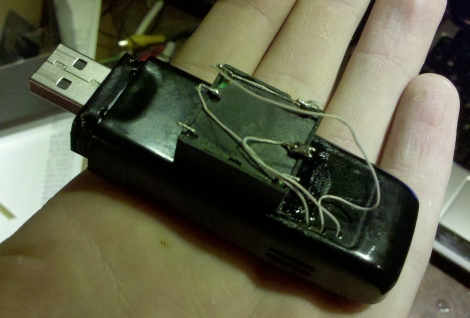
Hack-a-Day forum member [Necromant] was recently working on a router when he made a terrible mistake. He connected the wrong power brick to the router, causing a 2.5v over-voltage. The router itself was just fine, as it contained a good stepdown converter, but the HSDPA modem connected to the router’s USB port was not so lucky. It seems that the USB host is powered directly from the router’s power supply without any conversion – this meant his modem got a nice 7.5v zap when he used the wrong plug.
He assumed the modem was dead, so he figured there was no harm in disassembling it. He examined the modem’s circuit board and found that when plugged in, the onboard stepdown converter supplied 0 volts to the rest of the PCB. He couldn’t find any documentation for the converter online, so he employed a little bit of trial and error clever investigation to determine what sort of voltage the stepdown provided before being cooked.
After a bit of testing with his home-built low dropout regulator, he determined that the damaged stepdown provided 3.3v to the rest of the modem (that’s a 4.2v over-voltage for those of you who are keeping track). He added a linear voltage regulator to the board in place of the old stepdown, which worked for about 15 seconds before overheating.
In the end, he decided to add a pretty hefty 3.3v stepdown converter to the modem, throwing aesthetics to the curb. The result is one ugly, but quite functional HSDPA modem.














Be angry. While the USB spec states that bus power should not exceed 5 volts, it also states that devices should be able to survive over 20 volts of power applied to the power rails.
Just because the spec reads 20 volts and this one failed with 7.5 volts applied means very little. We don’t know the polarity of the brick, if it is regulated or non-regulated, if it is AC or DC.
If it was a non-regulated DC supply and he plugged the brick into the wall first then the initial voltage was quite a bit higher than 7.5 VDC. How high depends on the power supply voltage rating with nothing plugged in and the manufacturers never supply that number. A non-regulated 7.5 VDC, 300 ma power supply will be at 7.5 volts only when 300 ma is drawn from the supply.
For that matter the issue could have been under voltage of the supply is rated at 7.5 VDC, 300 ma and the box draws a amp.
BTW – I’ve seen more devices destroyed by someone plugging a reverse polarity or AC brick into a device designed for DC or the other polarity. The worse offenders are the non-regulated, multi-voltage supplies from WallyWorld. With one of these, if someone doesn’t understand what the box needs he has a less than 20% chance of getting it right the first time!
@ Tom Hargrave
I mistakenly plugged the 7.5V DC brick for my router into the 5V DC input of a loaded D-Link 7-port USB hub.
The keyboard, mouse and floppy drive connected were fried…
Fortunately the two >$300 multi-function printers survived…
So I guess the point is, cheaper USB devices will die with relatively low over voltage… but more expensive ones ought to live.
…oh, and the D-Link itself was fried…
you use floppies!?!
“…oh, and the D-Link itself was fried…” and nothing of value was lost.
I jest, I jest. On a serious note. @bemis Why the big hunking stepdown? Was that the only thing you had on hand or the only thing that would work?
I did this once. In my defense, there the power bricks cord WAS located in a cluster fuck of wires.
Pretty clunky, but it gets the job done, I suppose. I would really like to know what the numbers on the original IC were, just for my own curiosity. I always take notes when I do a repair like this (and I’ve done several kludges) so that I can come back to it later to return it to its original design.
@ hackersmith
I’m not the OP :)
…just pointing out that even though USB spec says devices must survive up to 20V, many will not even survive 7.5V
Nice hacky repair.
is it legal to open these?
my fios 4g connect card says under federal law im prohibited to tamper with the device
Some would say that’s a good reason to do it XD
@biozz, I had a cheap calculator that said that once… I opened it anyhow. I thought they put that on a lot of devices, especially RF devices to try and prevent people inexperienced in RF from creating interference, no?
@bemis Opps. That was your own personal story. Not a rehashing of what was in the article. Thats what I get for not reading the names very closely.
Thanks for putting it up here.
@bioz: WTF? Illegal? I got this modem from dealextreme, so I guess I’m allowed to do pretty much what I want. Besides I know of no russian federal law, that prohibits tempering with hardware here… Well, the result breaks local radio regulations.
@Necromant: Well, UNLESS, the result breaks local radio regulations.
Sorry for the typo.
needs moar heatshrink